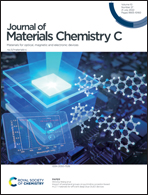Application of indacenodiselenophene central core and modulation of terminal group interaction for high-efficient P3HT-based organic solar cells†
Abstract
As one of the cheapest photovoltaic polymers, poly(3-hexylthiophene) (P3HT) has been considered as one of the prospective donor materials for commercial application. Thus, various non-fullerene acceptors (NFAs), especially A2–A1–D–A1–A2 type molecules comprising one electron-donating (D) unit and two electron-withdrawing (A) units have been designed to improve the photovoltaic performance of P3HT. So far, the central D unit has been dominated by large conjugated heterocycles fused with thiophene and benzene rings. Herein, indacenodiselenophene (IDSe) and benzo[d][1,2,3]triazole (BTA) were utilized as the central D part and bridged A1 unit respectively, to synthesize two novel A2–A1–D–A1–A2 type NFAs BTA46 and BTA47. To modulate the molecular planarity, absorption spectra and energy levels, 3-benzyl-rhodanine (R-Bn) and 3-benzyl-2-(1,1-dicyanomethylene)rhodanine (RCN-Bn) were used as the terminal units. P3HT:BTA47 combination demonstrates a higher PCE of 7.12% benefiting from the more efficient charge generation and transport in comparison with P3HT:BTA46 blend, which exhibits an inferior PCE of 3.99%. Detailed photoelectric properties and charge generation process analysis indicate that IDSe is a promising central core for A2–A1–D–A1–A2 type NFAs to combine with P3HT.



 Please wait while we load your content...
Please wait while we load your content...